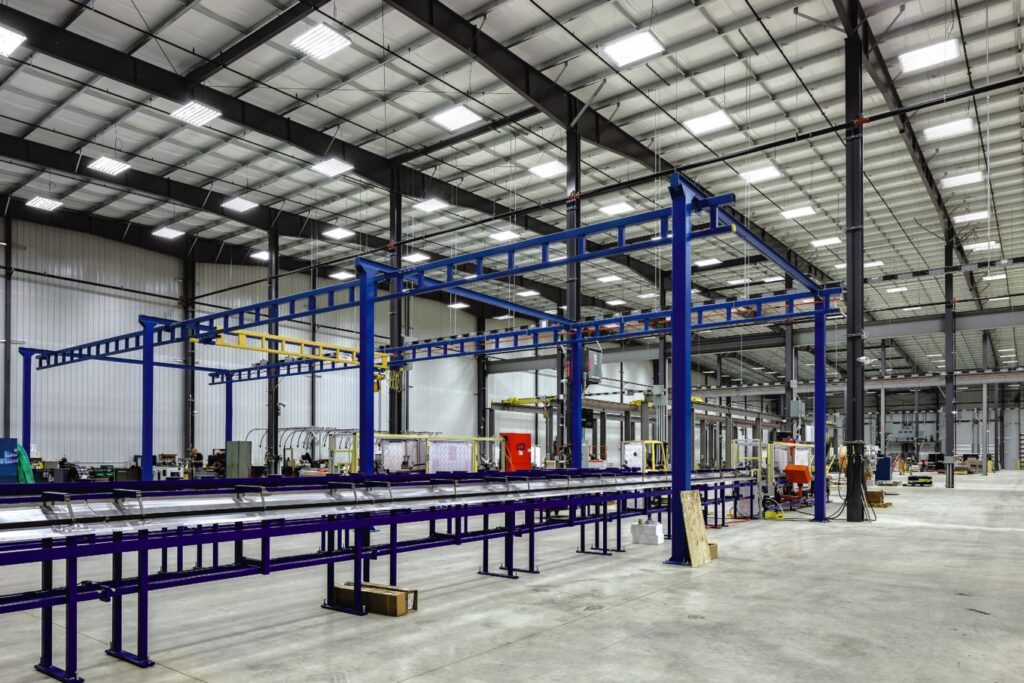Project Details

Looking at life cycle costs helps a Michigan manufacturer find the best value.
Maximum Value: The building owners thought of life cycle and maintenance costs.
3 Acres Big: This assembly facility boasts 120,000 square feet of floor space.
Major Crane Capacity: The building supports an interior crane that lifts up to 50 tons and spans 100 feet.
Business was booming for Burr Oak Tool, a heat transfer and tube processing machine tool provider. It had recently developed several innovative, industry-leading products, and it was well on its way to gaining market share.
But that was not always the case. In 1944, when Newell Franks worked with two other men to open Burr Oak Tool, they struggled at first. A spirit of ingenuity, combined with a strong Midwestern work ethic, has helped drive the company’s success ever since.
“My grandfather worked 50 hours a week until he was 95 years old. He instilled an ethic of hard work and good people doing good things.”
Newell Franks II, Burr Oak Tool
It’s no wonder that, as the management team planned a new 120,000-square-foot assembly facility, they focused on making decisions that not only make good business sense today, but also set the company up for maximum success in the future.
This project marked the company’s largest expansion to date. It is Burr Oak Tool’s sixth Butler® building, and the management team was determined to ensure they made smart decisions — decisions that could benefit the business for the next 30 years or more.
The facilities group at Burr Oak Tool started by working with James Ware Construction, Inc., a Butler Builder®, to identify a design for a building that could be expanded up to four times its size.
“We want the business leaders of tomorrow to look back and appreciate that the decisions we made today are still relevant in their time. It’s easy to think about what’s the least expensive course of action today and to take it without a second thought. But that type of thinking will not really result in maximum savings. To truly identify the lowest-cost option, future maintenance and operating costs must be factored in. By considering costs over the life cycle of a product, you’ll find that, often, the least expensive option today will end up costing you more over time.”
Newell Franks II, Burr Oak Tool
Examining life cycle and maintenance costs, along with initial prices, enables businesses to make total cost-of-ownership projections. This allows them to ensure they are identifying the most efficient options for capital expenditures.
“It cost us a little bit more to do the thermal block system, but it will more than pay for itself. In fact, it’s cheaper, at first, to have a flat membrane roof than to do a standing-seam metal roof, but you’ll have to replace a membrane roof every 10 years, whereas the Butler roof will last 40 or 50 years if you take any kind of care of it. Think about the life cycle cost.”
Newell Franks II, Burr Oak Tool
The building design for this new assembly facility was driven by the need for square footage. Franks, an engineer himself, worked with the design team at James Ware Construction to develop a plan for a facility that was 400 feet wide to avoid the need for internal gutters. The internal crane dictated the 38-foot eave height. The crane can lift 50 tons and spans 100 feet.
Choosing a Butler® building system was an easy decision for Franks, who has been working with James Ware Construction and Butler since the late 1980s. In his experience, there never has been a problem with roofing or siding across multiple projects.
“When you deliver a quality product that customers can depend on, that’s what keeps them coming back. For nearly 30 years, we’ve watched Burr Oak Tool grow, and we’ve helped them create new space to build their business. Newell is just one of those people who gets it. He gets that buildings are business decisions, and it’s great to see the company thrive.”
James Ware, James Ware Construction
Now that the facility is finished, more than 100 employees work there, swiftly moving their way through a backlog of customer orders and maintaining their commitment to dependability. And, every day, they welcome visiting customers from among more than 70 countries Burr Oak Tool serves. Most often, customers react with awe — it’s not every day you’re able take in the magnitude of an open building with nearly three acres of floor space.
The building was completed just in time for the firm’s 70th anniversary celebrations. The new assembly facility stands as an emblem of the progress and power of America’s family-owned businesses.
James Ware Construction, Inc.
jameswareconstructioninc.com
Connect with us for details about how we can solve your specific wall system needs.
© 2025 BlueScope Buildings North America, Inc. All rights reserved. Butler Manufacturing™ is a division of BlueScope Buildings North America, Inc.